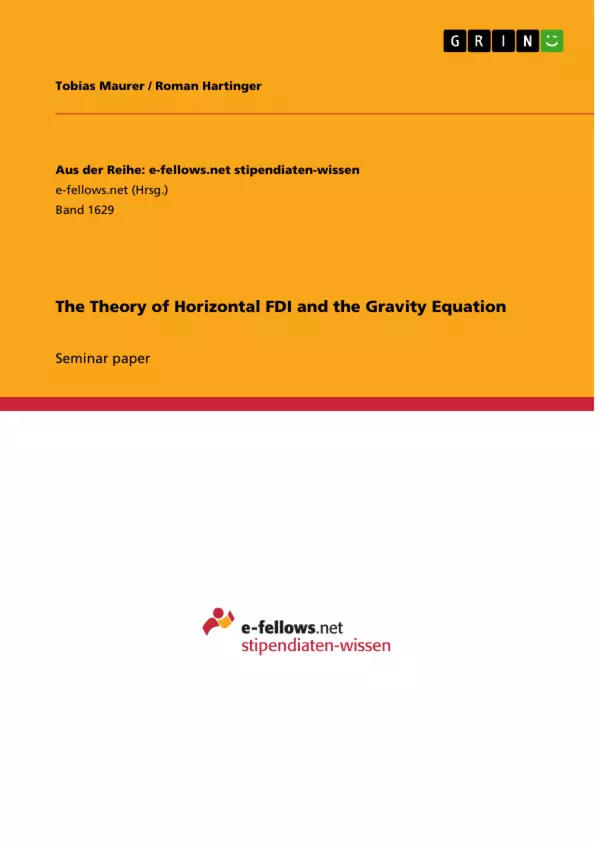The gravity equation is a common and often used empirical technique to analyse bilat-eral trade. The relationship between the theoretical background of multinational firms and findings from the empirical research with the gravity equation, however, had not been proven to be strong. This results from the fact that gravity equations which try to explain foreign affiliate sales are ad hoc and therefore the coefficients estimated by them are hard to interpret.
That is why Kleinert and Toubal (2010), from now on re-ferred to as K&T, further elaborate the theoretical origin of the structural gravity equa-tion by Redding and Venables (2003) which they use to analyse exports and FDI. In their paper they focus on three different theoretical models. Two models on horizontal FDI by Brainard (1997) and by Helpman et al. (2004) and one on vertical FDI by Ve-nables (1999). After the theoretical part they try to apply the gravity equations they derived on a dataset on affiliate sales to analyse if these equations hold true in the empirical analysis.
In our paper we will focus on the theoretical origins of the two models on horizontal FDI, since these are the models who hold in the empirical test. Our focus lies on the derivation of these models. We show the differences among the models themselves, as well as the similarities and differences between the original models and the revised models by K&T.
We will further show how these models lead to the gravity equations by analysing its connections with the structural gravity equation by Redding and Vena-bles (2003) in greater detail.
Summing up, the paper of K&T is very rich in information but rather short considering the scope. This is why they abbreviate some of the theoretical underpinnings behind the models. With our paper we want to give some further insides concerning the hori-zontal FDI models to ensure a better understanding of the paper by K&T and the intu-itions behind their elaborations.
Inhaltsverzeichnis (Table of Contents)
- Introduction
- Theory of Horizontal FDI
- Theory of symmetric firms and intermediate inputs
- Theory of heterogeneous firms and fixed costs increasing with distance
- Gravity equation
- From aggregate affiliate sales to the gravity equation
- The gravity equation and its application for the empirical analysis
- Conclusion
- Critical reception
Zielsetzung und Themenschwerpunkte (Objectives and Key Themes)
This paper analyzes the theoretical foundations of two horizontal foreign direct investment (FDI) models used by Kleinert and Toubal (2010) in their paper "Gravity for FDI". The models build upon the work of Brainard (1997) and Helpman et al. (2004) and aim to demonstrate how the gravity equation can be derived from these theoretical models. The paper further investigates the empirical testing of these models and their implications for understanding FDI patterns.
- The derivation of horizontal FDI models from the theoretical work of Brainard and Helpman et al.
- The role of intermediate goods and distance-dependent fixed costs in determining FDI decisions.
- The application of the structural gravity equation to analyze aggregate affiliate sales.
- The empirical testing of the gravity equation for horizontal FDI models.
- The comparison of the theoretical and empirical findings regarding FDI patterns.
Zusammenfassung der Kapitel (Chapter Summaries)
- Introduction: This chapter sets the stage for the paper, highlighting the importance of understanding the theoretical foundations of FDI models and their connection to empirical observations through the gravity equation. It introduces the work of Kleinert and Toubal (2010) and their focus on horizontal FDI models based on Brainard and Helpman et al., setting the context for the subsequent analysis.
- Theory of Horizontal FDI: This chapter delves into the theoretical underpinnings of two horizontal FDI models. First, it explores the model by Brainard (1997) which analyzes the proximity-concentration trade-off faced by firms. Then, it presents the model by Helpman et al. (2004) that introduces heterogeneous firms with varying productivities. Both models highlight the factors influencing a firm's choice between exporting and FDI.
- Gravity Equation: This chapter focuses on the derivation of the gravity equation from the theoretical FDI models presented in the previous chapter. It explains how the equation is used to analyze aggregate affiliate sales and highlights the key elements of the structural gravity equation approach, drawing insights from the work of Redding and Venables (2003). The chapter also discusses the empirical testing of the gravity equation and its findings.
Schlüsselwörter (Keywords)
The main keywords and focus topics of the text include foreign direct investment, horizontal FDI models, gravity equation, proximity-concentration trade-off, intermediate goods, distance-dependent fixed costs, heterogeneous firms, productivity, structural gravity equation, empirical analysis, affiliate sales, trade barriers, transportation costs, market capacity, supply capacity.
- Arbeit zitieren
- Tobias Maurer (Autor:in), Roman Hartinger (Autor:in), 2015, The Theory of Horizontal FDI and the Gravity Equation, München, GRIN Verlag, https://www.hausarbeiten.de/document/309714


